Last updated: October 28, 2021
Article
Full Grooved Axes
The full grooved axe, the first type of axe developed by the Indigenous peoples of North America, was an essential part of a larger tool kit of ground stone tools that Native North Americans began making during the Archaic period, between 9,000-2,700 years before present (BP).
Between 1948 and 1953, archeologist Roland Robbins conducted a massive excavation to investigate the English industrial history of the Iron Works at Saugus. During the project, Robbins also found a considerable number of Indigenous artifacts, including a variety of projectile point types, stone fragments representing different stages of the production process, and ceramic fragments, as well as a series of ground stone tool types. There were two intact full grooved axes found during this excavation and their manufacture, function, and use will be the focus of this article.
To understand what the presence of these artifacts suggests about the use of the Saugus landscape we will first explore two essential questions: What is the function of a grooved axe? How were grooved axes and other types of ground stone tools made?
What is a grooved axe and what was it used for?
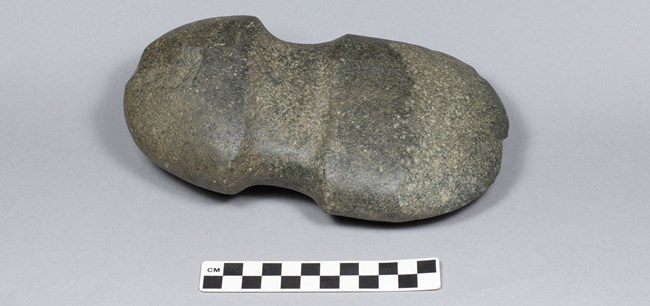
NPS Photo / Lissa Herzing / NPS Museum Collections, SAIR 3878
A grooved axe is a large stone tool, one end typically tapered, with a groove around the midsection where a split wooden handle would have been attached or hafted to the stone using animal sinew.
Grooved axes were used by Native Americans to aid in the chopping down of trees and splitting wood. It was a necessary wood working tool in the kit produced and used by Indigenous North Americans.
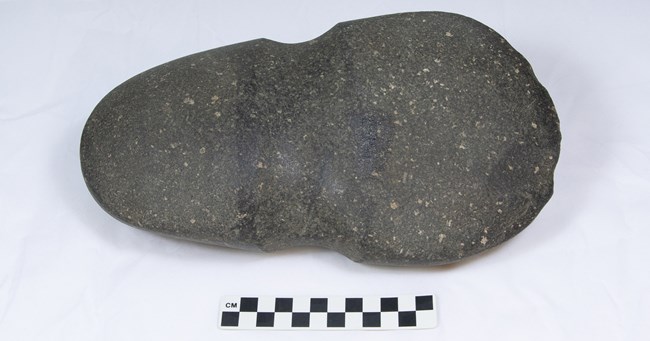
NPS Photo / Lissa Herzing / NPS Museum Collections, SAIR 1567
The two grooved axes featured here are considered full grooved axes, meaning that the groove goes completely around the circumference of the tool. They were produced during the Early Archaic period, about 9,000-8,000 years before present (BP).
These were the first types of grooved axes produced, later types did not have full grooves, instead the grooves would only go ¾ of the way or only halfway around the tool, likely reflecting changes in how it was hafted to a wooden handle.
How were grooved axes and other types of ground stone tools made?
As opposed to the relatively short amount of time it took to chip an arrowhead or knife blade, grooved axes and other ground stone tools were created by a time-consuming process of grinding and pecking. Using a secondary stone made of a harder material, a tool maker would gradually peck or grind away stone to create the desired shape. This secondary stone is referred to as a hammerstone, another type of tool that is frequently found at Indigenous archeological sites in New England. Sand, or a finer grained stone, was then used to polish the surface of the finished tool.
The axes in the museum collection at Saugus Iron Works are finished products, but what would it look like if we found something archaeologically that was a tool in progress? Below, you can see a small cobble that has a line pecked into it following the circumference of the stone. This artifact likely illustrates the beginning stages of the process of creating a ground stone tool. The partially worked stone could also represent a tool maker practicing their technique.
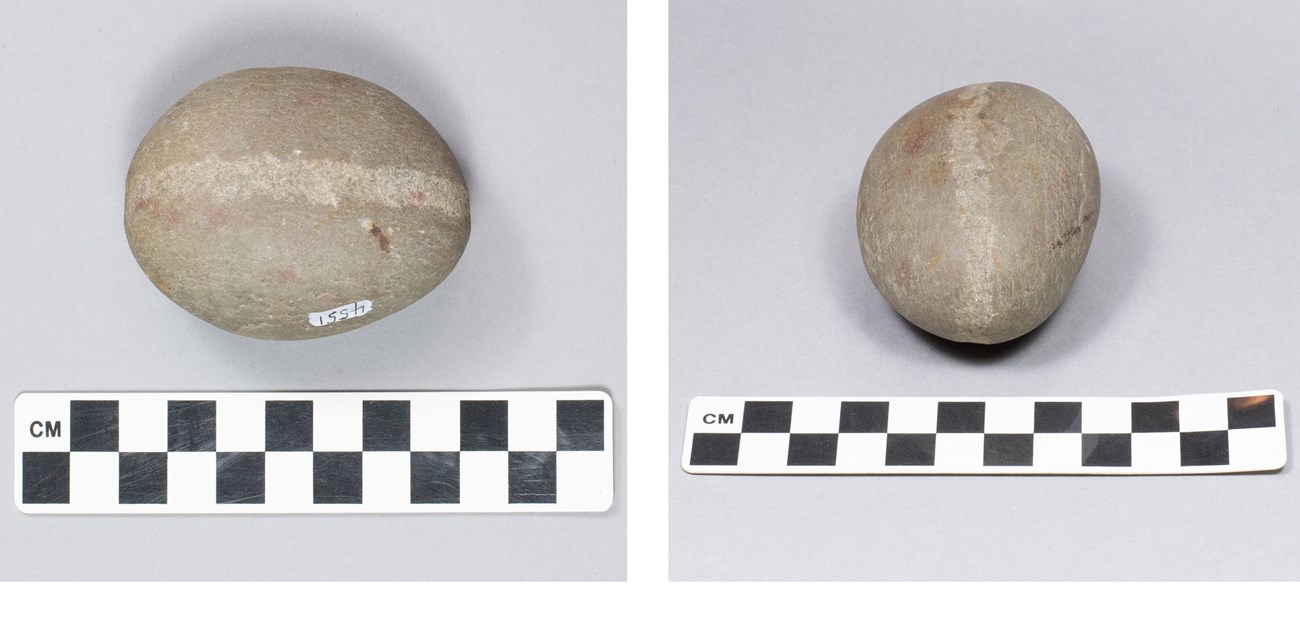
NPS Photo / Lissa Herzing / NPS Museum Collections, SAIR 4551
Specific types of stones were required to make ground stone tools, some of which include igneous rocks like rhyolite, basalt and granite, or metamorphic types of rock like quartzite or marble, or occasionally even sandstone. Ground stone tools, like their chipped stone counterparts, were essential to the lifeways of Indigenous peoples in the Archaic and Woodland periods in New England.
What other types of ground stone tools would have been used alongside grooved axes?
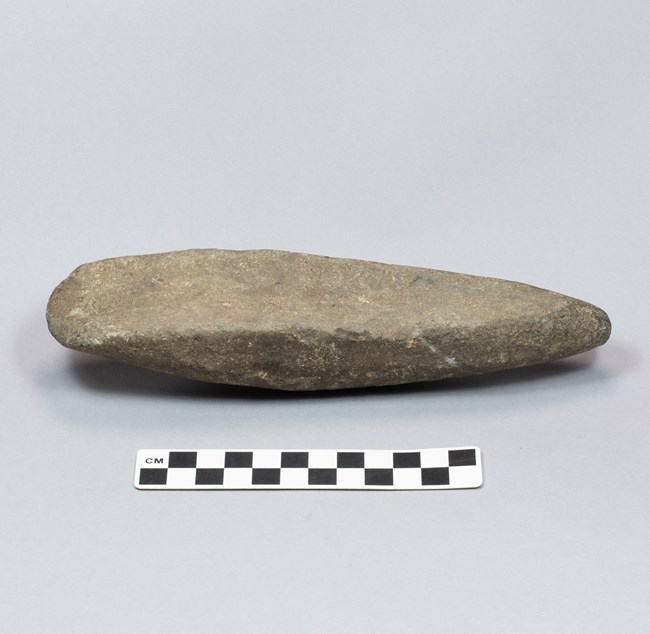
NPS Photo / Lissa Herzing / NPS Museum Collections, SAIR 2950
Several other ground stone tools are a part of the Indigenous wood working tool kit, including celts, mauls, adzes, and gouges. The celt, which is a stone shaped to a taper at one end with no groove, replaced the grooved axe during the Woodland period. Also used to help fell trees and process wood like grooved axes, celts would have been attached to handles for ease of use. A maul is a type of hammerstone that was modified with the addition of a groove to be hafted to a wooden handle. Adzes are another wood working tool used similarly to axes and celts as a hard impact tool, also attached to a wooden handle. Gouges were used more for carving wood, which can be seen in their shape as one side of the stone has been hollowed out to create a channel.
The gouge pictured here is likely from the Archaic period (9,000-2,700 years before present). These tools, together with the grooved axe, enabled Indigenous people to utilize wood in their everyday lives.
Grooved Axes and the Saugus Iron Works Landscape
What does the presence of grooved axes suggest about the use of the Saugus Iron Works landscape by Indigenous peoples? The chipped stone tool evidence recovered through archeological excavations suggests that the site was used as a production location for chipped stone tools. This assertion is supported by the presence of stone flakes, the byproducts of stone tool production, in various sizes, partially completed and fully completed tools, as well as large chunks of raw material harvested from local or regional quarries. In the context of a site of stone tool manufacture, the presence of grooved axes suggests that there was also wood felling occurring in the area, to either sustain the manufacture camp in the form of fire and structure building or the harvesting of resources to be transported back to other settlement locations.
It is hard to say whether these grooved axes or other ground stone tools were produced at the site of Saugus Iron Works. The residue of their manufacture is much harder to identify than that of chipped stone tools, which leave behind thousands of identifiable flakes of varying sizes. There are several stones in the museum collection at Saugus Iron Works that were used as hammerstones by Indigenous people, suggesting that ground stone tools generally were being produced at the site. However, it is unclear whether the full grooved axes were produced at Saugus. To support the hypothesis that Saugus Iron Works was a site where the grooved axes were used rather than produced, there is considerable evidence of use wear on both grooved axes in the site’s museum collection.
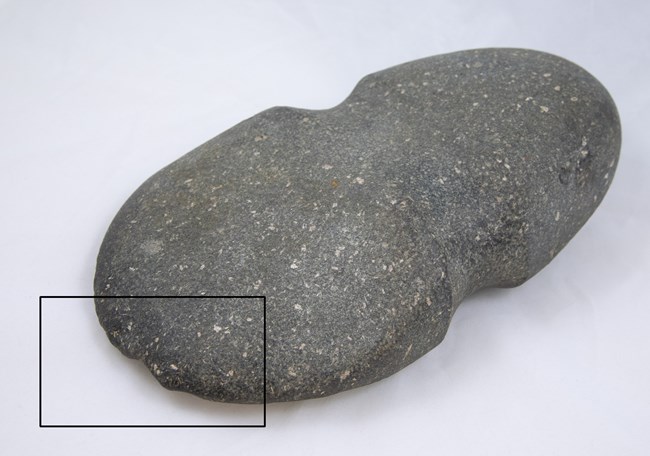
NPS Photo / Lissa Herzing / NPS Museum Collections, SAIR 1567
In the image here, you can see on the wide end of this grooved axe that there are chips of stone missing. These imperfections in the stone were not created in the production of the tool but rather its use. These grooved axes were produced and used during the Early Archaic period, from about 9,000-8,000 years before present (BP), and at some point, they were deposited archeologically.
These axes seem to be in great condition, so why would someone discard them? One theory is that the axes were being stored at the site for future use, rather than intentionally being discarded. They are heavy stones, and perhaps their users did not want to have to carry them long distances, so they opted to leave them behind for when they would return to the site.
Selected Bibliography and Continued Reading
Bradley, James W. 1996. “A Cache of Middle Archaic Ground Stone Tools from Lawrence, Massachusetts.” Bulletin of Massachusetts Archaeological Society, Vol. 57, No. 2, pp. 46-49.
Hoffman, Curtiss. 1991. A Handbook of Indian Artifacts from Southern New England. Revised from original text by William S. Fowler. Massachusetts Archaeological Society.
Hothem, L., 1989. American Indian Axes and Related Stone Artifacts. Collector Books.
Krakker, James J. 2011. “A Hafted Stone Celt from Genesee County, Michigan and Implications for Ground Stone Tool Use in the Eastern Woodlands.” Midcontinental Journal of Archaeology, Vol. 36, No. 1, pp. 5-28.
Will, Richard T. 2002. “Understanding Archaic Period Ground Stone Tool Technology Through Debitage Analysis from the Clark I Site, Norridgewock, Maine.” Archaeology of Eastern North America, Vol. 30, pp. 29-38.
